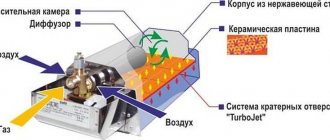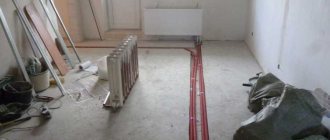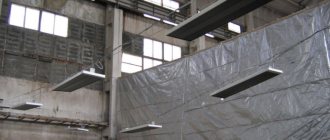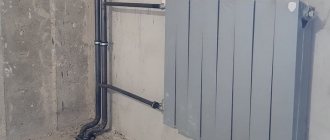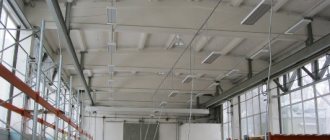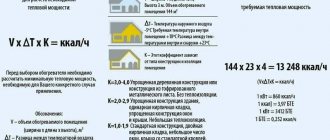Heating calculation
To carry out a thermal calculation, before planning any industrial heating, you need to use the standard method.
Qt (kW/hour) =V*∆T *K/860
Where:
- Qt – heat load on the heated space;
- V – internal area of the room requiring heating (W*D*H);
- ∆ T – the value of the difference between the external and desired internal temperature;
- K – heat loss coefficient;
- 860 – recalculation per kW/hour.
The heat loss coefficient, which is included in the calculation of the heating system for industrial premises, varies depending on the type of building and the level of its thermal insulation. The less thermal insulation, the higher the coefficient value.
Choosing a system for heating industrial premises
Heating of industrial premises is carried out using different types of systems, each of which requires detailed consideration.
Centralized liquid or air systems are the most popular, but local heaters can also often be found. The choice of heating system type is influenced by the following parameters:
- dimensions of the heated room;
- the amount of thermal energy required to maintain the temperature regime;
- ease of maintenance and availability of repairs.
Each system has its pros and cons, and the choice will primarily depend on the compliance of the functionality of the selected system with the requirements that apply to it. When choosing the type of system, it is necessary to calculate the heating system of an industrial building in order to have a clear understanding of how much heat the building needs.
SNiP standards for heating industrial premises
There are quite a lot of general provisions of SNiP, and they are described very extensively. We intend to highlight only their essence.
- Heating of industrial premises should be designed taking into account heat loss, heat consumption for heating air, objects, and equipment. Allowable heat loss is no more than three degrees difference between the temperature inside and outside.
- The maximum permissible coolant parameters are 90 degrees and 1.0 MPa.
- It is advisable to use only water as a coolant; all other materials should be technically justified.
- If heated by electricity, then all equipment must meet the requirements.
- Heating of staircase landings is not designed.
- If there is more than 50 square meters of floor space per employee, then permanent workplaces must have the previously specified temperature, and non-permanent workplaces must have at least 10 degrees.
- Gas equipment can only be used when combustion products are removed closed.
Features of steam heating of industrial buildings
Steam systems are often used to heat industrial buildings. Steam has both advantages and disadvantages.
pros
- The air temperature remains at a consistently high level.
- The height of the building is not important - steam heating works great in buildings of any number of floors.
- Both the equipment and the heating main are relatively small.
- The air warms up quickly and cools just as quickly.
Minuses
- Steam heating systems are very noisy.
- There is no way to regulate steam flow, and therefore heat transfer too.
At the same time, steam is much better suited than water for heating industrial premises.
Air heating
Most enterprises during the existence of the Soviet Union used a convection heating system for industrial buildings.
The difficulty in using this method is that warm air, according to the laws of physics, rises, while the part of the room located near the floor remains less heated. Today, more efficient heating is provided by an air heating system for industrial premises.
Operating principle
Hot air, which is preheated in the heat generator through air ducts, is transferred to the heated part of the building. Distribution heads are used to distribute thermal energy throughout the space. In some cases, fans are installed, which can be replaced by portable equipment, including a heat gun.
Advantages
It is worth noting that such heating can be combined with various supply ventilation and air conditioning systems. This is what makes it possible to heat huge complexes, something that could not be achieved before.
This method is widely used in heating warehouse complexes, as well as indoor sports facilities. In addition, this method in most cases is the only possible one, since it has the highest level of fire safety.
Flaws
Naturally, there were some negative properties. For example, installing air heating will cost the owners of an enterprise a pretty penny.
Not only do the fans necessary for normal operation cost quite a lot, but they also consume huge amounts of electricity, since their productivity reaches about several thousand cubic meters per hour.
When traditions don't warm you up
Air heating diagram, fig. 1
First of all, it is worth understanding why water heating systems, so common for small residential and office premises, are not suitable for workshops, warehouses or hangars.
Air heating system diagram, fig. 2
The fact is that rooms in apartments and private houses, as well as offices, most often have a ceiling height of no higher than 3-4 m. Warm air flows from heating devices located under the windows or along the walls rise upward. Because of this, the difference in air temperature between the floor and ceiling increases by 2°C with each meter. Thus, in living rooms this difference can reach 6-8°C, which is quite acceptable, since a comfortable temperature (+18-22oC) should be maintained only up to the height of human growth.
Air heating system, diagram, fig. 3
But the higher the ceiling, the more uneven heating increases. In a room heated by convection, warm air predominantly accumulates under the ceiling, which naturally increases heat loss through the floors or roof. At the same time, at the height of human growth, the temperature remains much lower than comfortable.
Air heating diagram, fig. 4
Due to the huge temperature difference between the floor and the ceiling, when using water heating systems in rooms with high ceilings, it is necessary to resort to additional measures to uniformly heat the entire volume of air. These can be electric or water “warm floors” or ceiling fans, which further increases the already considerable costs of heating the building. All this makes water heating an extremely unprofitable and ineffective solution for heating buildings with high ceilings. So it is gradually being abandoned in favor of more economical air systems.
, diagram, fig. 5
Infrared heating
Not every company is ready to spend a lot of money on an air heating system, so many prefer to use another method. Infrared industrial heating is becoming increasingly popular every day.
Principle of operation
An infrared burner operates on the principle of flameless combustion of air located on the porous part of the ceramic surface. The ceramic surface is distinguished by the fact that it is capable of emitting a whole spectrum of waves that are concentrated in the infrared region.
The peculiarity of these waves is their high degree of permeability, that is, they can freely pass through air currents in order to transfer their energy to a certain place. The stream of infrared radiation is directed to a predetermined area through various reflectors.
Therefore, heating industrial premises using such a burner allows for maximum comfort. In addition, this heating method makes it possible to heat both individual work areas and entire buildings.
Main advantages
At the moment, the use of infrared heaters is considered the most modern and progressive method of heating industrial buildings due to the following positive characteristics:
- quick heating of the room;
- low energy intensity;
- high efficiency;
- compact equipment and easy installation.
By performing the correct calculation, you can install a powerful, economical and independent heating system for your enterprise that does not require constant maintenance.
Scope of application
It is worth noting that such equipment is used, among other things, for heating poultry houses, greenhouses, cafe terraces, auditoriums, shopping and sports halls, as well as various bitumen coatings for technological purposes.
Central water heating
In the case of a central heating system, heat production will be provided by a local boiler house or a single system that will be installed in the building.
The design of this system includes a boiler, heating devices and piping. The operating principle of such a system is as follows: the liquid is heated in the boiler, after which it is distributed through pipes to all heating devices. Liquid heating can be single-pipe or double-pipe. In the first case, temperature control is not carried out, but in the case of two-pipe heating, the temperature regime can be adjusted using thermostats and radiators installed in parallel.
The boiler is the central element of a water heating system. It can run on gas, liquid fuel, solid fuel, electricity or a combination of these types of energy resources. When choosing a boiler, you must first take into account the availability of one or another type of fuel.
For example, the ability to use mains gas allows you to immediately connect to this system. At the same time, you need to take into account the cost of the energy resource: gas reserves are not unlimited, so its price will increase every year. In addition, gas mains are very susceptible to accidents, which will negatively affect the production process.
Using a liquid fuel boiler also has its pitfalls: to store liquid fuel, you need to have a separate tank and constantly replenish the reserves in it - and this is an additional expense of time, effort and finance.
Solid fuel boilers are generally not recommended for heating industrial buildings, except in cases where the building area is small. True, there are automated versions of boilers that are capable of independently taking fuel, and in this case the temperature is adjusted automatically, but maintenance of such systems cannot be called simple. For different models of solid fuel boilers, different types of raw materials are used: pellets, sawdust or firewood. A positive quality of such structures is the low cost of installation and resources.
Electric heating systems are also poorly suited for heating industrial buildings: despite their high efficiency, these systems use too much energy, which will greatly affect the economic side of the issue. Of course, for heating buildings up to 70 sq.m. Electrical systems are fine, but you need to understand that electricity also tends to go out regularly.
But what you can really pay attention to is combined heating systems. Such designs can have good performance and high reliability. A significant advantage over other types of heating in this case is the possibility of uninterrupted heating of an industrial building. Of course, the cost of such devices is usually high, but in return you can get a reliable system that will provide the building with heat in any situation.
Combined heating systems usually have several types of burners built in, which allow the use of different types of raw materials.
It is by the type and purpose of the burners that the following designs are classified:
- gas-wood boilers: equipped with two burners, they allow you not to worry about rising fuel prices and problems with the gas supply line;
- gas-diesel boilers: demonstrate high efficiency and work very well with large areas;
- gas-diesel-wood boilers: extremely reliable and can be used in any situation, but power and efficiency leave much to be desired;
- gas-diesel-electricity: a very reliable option with good power;
- gas-diesel-wood-electricity: combines all types of energy resources, allows you to control fuel consumption in the system, has a wide range of settings and adjustments, is suitable in any situation, requires a large area.
The boiler, although it is the main element of the heating system, cannot independently provide heating to the building. Can a water heating system provide the necessary heating for a building? The heat capacity of water is much higher when compared with the heat capacity of air.
This suggests that the pipeline can be much smaller than in the case of air heating, which indicates better efficiency.
In addition, a water system makes it possible to control the temperature in the system: for example, setting the heating at night at 10 degrees Celsius can significantly save resources. More accurate figures can be obtained by calculating the heating of industrial premises.
Water heating systems for industrial premises
In this case, the heat source can be the local boiler house of the enterprise or even a centralized heat supply. The main element of such a system is a special boiler that runs on gas, electricity or solid fuel. Of course, it is best to choose gas or coal as the latter, but the latter option will be somewhat more expensive. Other types of fuel will cost the organization much more, and therefore it is hardly advisable to use them.
Features of water thermal installations
When using water as a coolant for heating a building, the following features of such systems must be taken into account:
- constant high blood pressure;
- high temperatures;
- are used mainly for moderate heating of objects (the temperature on average should be kept at plus ten degrees), unless, of course, this is detrimental to the production process.
Water heating of the production workshop
If the plant has central water heating, then heat will be supplied using a local boiler house. Or due to a single system installed in the building.
The equipment includes a pipeline, a boiler and heating devices. The principle of operation is simple: the liquid heated in the boiler is distributed through a pipeline to all installed devices.
There are two types of water heating for production workshops:
- single-pipe (no temperature control function);
- two-pipe (you can control the temperature using parallel installed radiators and thermostats).
When choosing a boiler, you should pay attention to some features. The central element of liquid heating can run on electricity, solid and liquid fuel or gas. In addition, a combination of energy resources is possible. Therefore, when selecting a boiler, it is recommended to take into account the availability of certain resources. In this case, more economical heating of the workshop is possible.
The use of this heating system is in great demand due to the adequate price-quality ratio.
IR gas heaters
It is worth noting right away that this type of fuel for IR heaters has a lot of advantages, which are precisely what many potential buyers appreciate. The very first and most important of them is the cost-effectiveness of the device to use.
You can compare it with any other type of heating, and you can immediately see that the fuel costs of an infrared heater are approximately 70% less. In fact, if you use an industrial infrared heating system, then this system will be able to pay for itself in the next couple of seasons.
Types of gas heaters
To begin with, we will definitely separate the heaters into two groups. Infrared ceiling heaters intended for production sites will be divided into:
- Light emitters. These devices are designed specifically to heat factories where ceilings are more than 4 meters high. At the moment, these are one of the most popular devices in industrial production. According to calculations, approximately for every 20 - 25 meters, you will need 1 installation with a power of 1 kW. If it is necessary to warm up about 100 cubic meters, then use mounted heaters with a power of 5 kW. During their operation, the gas outlet channel will eliminate combustion products, which are extremely harmful to health.
- Dark type of emitters. In this type of system, gas begins to be absorbed only at a temperature of no more than 400 degrees. Due to this, the metal tube will not glow red-hot during operation, which is where the name of the emitters actually came from. Before you start installing such heaters, it is worth considering that they are quite small, unlike light emitters. But factories and other industrial facilities purchase both types of emitters. The choice is up to the buyer.
Advantages of gas-type emitters
For the industrial type of gas emitter, a number of specific advantages can be identified, which are clearly appealing to many buyers:
- there is an opportunity for the enterprise to heat the premises locally;
- fairly low heat costs;
- the device will pay for itself in literally 2–3 years;
- no need to spend money on staff to serve;
- can be turned on at any convenient time of the year;
- extremely fast heating of a large cold zone.
The only caveat is that this type of heater is not particularly suitable for home use. That's why it's called industrial. In order to use it, ceilings of at least 3–4 meters are required. If the height is below 3 meters, then using the emitter is dangerous.
Sequence of actions when installing air heating
To install an air heating system for a workshop and other production premises, you must adhere to the following sequence of actions:
- Development of a design solution.
- Heating system installation.
- Carrying out commissioning and testing of air and automation systems.
- Acceptance for operation.
- Exploitation.
Below we will consider each stage in more detail.
Air heating system design
The correct location of heat sources around the perimeter will allow the rooms to be heated in the same volume. Click to enlarge.
Air heating of a workshop or warehouse must be installed in strict accordance with a previously developed design solution.
You should not carry out all the necessary calculations and select equipment yourself, since errors in design and installation can lead to malfunctions and the appearance of various defects: increased noise levels, imbalance of air supply to rooms, temperature imbalance.
The development of a design solution should be entrusted to a specialized organization, which, based on the technical conditions (or technical specifications) submitted by the customer, will solve the following technical problems and issues:
- Determination of heat losses in each room.
- Determination and selection of an air heater of the required power, taking into account the amount of heat loss.
- Calculation of the amount of heated air taking into account the power of the air heater.
- Aerodynamic calculation of the system, performed to determine the pressure loss and diameter of the air channels.
Air heating system: pros and cons
Advantages
You can set the thermostat to a low maintenance temperature (so that the water does not freeze) and leave the unit for a while. Upon return, the regulator switches back and the building warms up.
If necessary, you can set a flexible temperature regime: one at night, another during the day.
Air heating can work alongside a humidifier in dry climates while avoiding the problems associated with static electricity build-up.
In regions with a humid climate, air heating systems dry the indoor air, which will prevent moisture condensation and the spread of fungus and mold.
Air heating systems with an air intake inside the building are equipped with purifying filters or ionizers, this allows you to remove polluting particles and allergens from the air.
During the warm season, air ducts of forced draft air heating systems supply cold air to the rooms.
Fans of air heating systems, in the presence of forced draft, are used in conjunction with solid fuel stoves, heating the house in the event of unforeseen failures or planned interruptions in the operation of centralized heating. Such an alternative system, located near the air intake fan, can assist the main heating system in particularly severe cold weather.
Air heating systems
Such heating can be done either local or centralized; and it is distinguished by the following features:
- air masses are constantly in motion;
- the air is regularly changed and cleaned;
- the temperature is more evenly distributed throughout the rooms;
- harmless to humans.
The heated air enters the workshop through air ducts, where it is mixed with the existing air. Moreover, most of it then passes through special filters, is heated again and used. Thus, energy losses are minimized. In addition, such a system provides air supply from outside, which already meets sanitary standards. However, if during the production process some harmful substances are released into the atmosphere, then such a recycling system is unlikely to be effective and safe. In this case, you will have to completely remove all the air coming out.
Note that when using local air heating, the heat source is located in the center of the building. The latter is usually taken as VOA, heat guns and the like. However, only the air inside can be processed in this way, and fresh air masses will not be supplied.
Airborne solar collector
Local heating scheme
When the area of the heating system extends to just one room in which the heat center itself is located, the scheme is called a local air heating scheme for industrial premises. The calculation and selection of the scheme are made depending on the specifics of the production facility and taking into account a number of operational requirements.
Central heating circuit
Another name for this scheme is channel. Its meaning is that the air is heated to the required temperature in the thermal center, and then supplied to the premises through air ducts. The thermal installation can be placed both inside the building and outside.
Heating systems built according to the central type, in turn, can be recirculation, direct-flow, or partially recirculation.
Recirculation system. Requires relatively low initial costs, operating costs are also low.
Used in rooms where air circulation is allowed.
Partial recirculation system. It is a more flexible system, implemented due to mechanical impulses of air movement. It is capable of operating in different modes: with partial or complete air replacement. Can work in combination with ventilation units.
Direct flow system. The use of such a system is relevant for rooms in which explosive, toxic or fire hazardous substances are released - in cases where the penetration of these substances into other rooms is unacceptable.
Choosing a heating system for industrial premises
Warehouses also need heating
For heating industrial buildings, central heating systems (water or air) are most often used, but in some cases it is more rational to use local heaters.
But in any case, when choosing a production heating system, you need to rely on the following criteria:
- Area and height of the room;
- The amount of heat energy needed to maintain the optimal temperature;
- The ease of maintenance of heating equipment, as well as its suitability for repair.
Now let's try to understand the positive and negative aspects that the above-mentioned types of heating of industrial premises have.
Central water heating
Scheme of traditional water heating
The source of the heat resource is a central heating system or a local boiler house. Water heating consists of a boiler, heating devices (radiators or convectors) and a pipeline. The liquid heated in the boiler is transferred to the pipes, giving off heat to the heating devices.
Water heating of industrial buildings can be:
- Single-pipe - here it is impossible to regulate the water temperature.
- Two-pipe - here temperature control is possible and is carried out thanks to thermostats and radiators installed in parallel.
Scheme of water heating production in the case of a local boiler house
As for the central element of the water system (that is, the boiler), it can be:
- gas;
- liquid fuel;
- solid fuel;
- electrical;
- combined.
You need to choose based on the possibilities. For example, if it is possible to connect to a gas main, a gas boiler would be a good option. But keep in mind that the price of this type of fuel increases every year. Plus, there may be interruptions in the central gas supply system, which will not benefit the production enterprise.
Gas industrial boilers
An oil-fired boiler requires a separate safe room and fuel storage tank. In addition, you will have to regularly replenish fuel reserves, which means taking care of transportation and unloading - additional costs of money, labor and time.
Viessmann liquid fuel boilers of different capacities
Solid fuel boilers are unlikely to be suitable for heating industrial premises, unless they are small in size. Operating and maintaining a solid fuel unit is a rather labor-intensive process (loading fuel, regularly cleaning the firebox and chimney from ash).
True, at present there are automated solid fuel models into which you do not need to load fuel yourself; a special automatic intake system has been developed for this. Also, automated models allow you to set the desired temperature.
However, you will still have to take care of the firebox and chimney for a solid fuel boiler. The fuel used here is pellets, sawdust, wood chips, and, if placed manually, also firewood. Although this type of boiler requires labor-intensive operation, it is the most inexpensive.
Solid fuel boiler Retra 3M
Electric boilers are also not the best option for large industrial enterprises, since the electricity consumed costs a pretty penny. But heating a production space of 70 square meters using this method is quite acceptable. However, do not forget that in our country, periodic power outages for several hours have long been a common occurrence.
As for combination boilers, they can be called truly universal units. If you have chosen a water heating system and want to get efficient and uninterrupted heating of your production as a result, then take a closer look at this option.
Although a combination boiler costs several times more than previous units, it provides a unique opportunity - practically not to depend on external problems (interruptions in the centralized heating system, gas supply and electricity supply). Such units are equipped with two or more burners for different types of fuel.
Built-in types of burners are the main parameter for dividing combined boilers into subgroups:
- Gas-wood heating boiler - you don’t have to worry about interruptions in gas supply and rising fuel prices;
- Gas-diesel - will provide high heating power and comfort in a large room;
- Gas-diesel-wood - has expanded functionality, but you have to pay for it with lower efficiency and low power;
- Gas-diesel-electricity is a very effective option;
- Gas-diesel-wood-electricity – an improved unit. It can be said that it provides complete independence from possible external problems.
Combined unit
Everything is clear with boilers, now let's see whether water heating in production fits the selection criteria that we initially outlined. Here it’s worth mentioning right away that the heat capacity of water, compared to the heat capacity of the same air, is several thousand times greater (at the usual temperatures of air (70°C) and water (80°C) in the heating system).
In this case, the water consumption for the same room will be thousands of times less than the air consumption. This means that fewer connecting communications will be required, which is certainly a big plus, given the design of industrial premises.
Note! A water heating system allows you to control the temperature: for example, you can set standby production heating (+10°C) during non-working hours, and set a more comfortable temperature during working hours.
Air heating
Air heater
This type is the very first artificial heating of premises. So air heating systems have been proving their effectiveness for quite a long time and, it should be noted, are in constant demand.
All this thanks to the following positive aspects:
- Air heating assumes the absence of radiators and pipes, instead of which air ducts are installed.
- Air heating shows a higher level of efficiency compared to the same water heating system.
- In this case, the air is heated evenly throughout the entire volume and height of the room.
- An air heating system can be combined with a supply ventilation and air conditioning system, which allows you to obtain clean air instead of heated air.
- It is impossible not to mention regular changes and air purification, which has a beneficial effect on the well-being and performance of employees.
Air ducts
In order to save money, it is better to choose combined air industrial heating, which consists of natural and mechanical air circulation. What does it mean?
The word “natural” means the intake of already warm air from the environment (warm air is available everywhere, even when it is -20°C outside). Mechanical induction is when the duct takes cold air from the environment, heats it and delivers it into the room.
Air heating production diagram
For heating a large area, air heating systems for industrial premises are perhaps the most rational option. And in some cases, for example, at chemical plants, air heating is the only permitted type of heating.
Infrared heating
How to heat an industrial premises without resorting to traditional methods? Using modern infrared heaters. They work on the following principle: emitters generate radiant energy above the heated area and transfer heat to objects, which in turn heats the air.
The figure clearly shows the operating principle of infrared heating
Information! The functionality of infrared heaters can be compared to the Sun, which also uses infrared waves to heat the earth's surface, and as a result of heat exchange from the surface, the air is heated.
This principle of operation eliminates the accumulation of heated air under the ceiling and, as a result, large temperature changes, which is very attractive for heating industrial enterprises, since most of them have high ceilings.
IR heaters are divided into the following types according to their installation location:
- ceiling;
- floor;
- wall;
- portable floor.
Infrared ceiling heaters
By type of waves emitted:
- shortwave;
- medium wave or light (their operating temperature is 800°C, so they emit soft light during operation);
- long-wave or dark (they do not emit light even at their operating temperature of 300-400 ° C).
Wall-mounted IR models
By type of energy consumed:
- electrical;
- gas;
- diesel
Infrared Ceiling Film
Gas and diesel infrared systems are more profitable and their efficiency is 85-92%. However, they burn oxygen and change the humidity in the air.
By type of heating element:
- Halogen - the only drawback is that if dropped or subjected to a strong impact, the vacuum tube may break;
- Carbon - the main heating element is made of carbon fiber and placed in a glass tube. The biggest advantage compared to other IR devices is lower energy consumption (about 2.5 times). If dropped or subjected to a strong impact, the quartz tube may break.
- Tenovye;
- Ceramic - the heating element is made of ceramic tiles assembled into one reflector. The principle of operation is the flameless combustion of a gas-air mixture inside a ceramic tile, as a result of which it heats up and transfers heat to surrounding surfaces, objects, and people.
IR heaters are most often used for heating:
- industrial premises;
- shopping and sports facilities;
- warehouses;
- workshops;
- factories;
- greenhouses, greenhouses;
- livestock farms;
- private and apartment buildings.
IR ceiling heaters
Advantages of infrared heating:
- First of all, it should be noted that IR heaters are the only type of devices that allow for zone or spot heating. Thus, different parts of the production facility can be maintained at different temperatures. Zone heating can be used to heat work areas, parts on a conveyor belt, car engines, young animals on livestock farms, etc.
- As mentioned above, IR heaters heat surfaces, objects and people, but do not affect the air itself. It turns out that there is no circulation of air masses, which means there is no loss of heat and drafts and, as a result, fewer colds and allergic reactions.
- The low inertia of infrared heaters allows you to feel the effect of their action immediately after starting, without preheating the room.
- Infrared heating is very economical, due to its high efficiency and low energy consumption (up to 45% less energy than traditional methods). There is probably no need to explain that this significantly reduces the financial costs of the enterprise and quickly pays back all the funds invested in infrared heating.
- IR heaters are durable, lightweight, take up little space, are easy to install (each product comes with detailed installation instructions) and require virtually no maintenance during operation.
- Infrared heaters are the only type of heating devices that can provide effective local heating (that is, without resorting to centralized heating systems).
Heating scheme for industrial premises
Despite the above, we will not use radiant heating for our scheme. The fact is that most of the industrial buildings are still of the Soviet type, with large heat losses. They require the most inexpensive heating option, preferably using alternative fuel.
So, the average volume of such buildings is 5760 cubic meters, and in order to make up for losses, a power of 108 kilowatts per hour is required. These are very approximate figures and depend on a number of factors. Let us only note that we must have another 30% power reserve. Our fuel is wood and pellets.
In order to obtain the power we need, about 40 kilograms of fuel per hour are required, and if in production there is an eight-hour working day (plus an hour break), then 360 kilograms of fuel will be required per day. On average, the heating season is 150 days, which means that in total we will need 54 tons of firewood. But this value is maximum.
Now let's calculate the cost. (see table)
| Name | Cost, per ton | Cost, per season |
| Firewood | 1000 rub. | 25,000 rub. |
| Pellets | 3200 rub. | 80,000 rub. |
The calculations were based on the fact that we would need 25 tons of fuel for the season. If we heat with gas, then we will need it for 260,000 rubles, and electricity – for the entire 360,000 rubles.
Are heaters harmful to industry?
None of the considered types of IR emitters cause harm to industrial premises and objects located in it. This is actually what they are designed for. But for humans there is harm only from emitters with short waves. But if you follow all the regulations and safety precautions, then there will be no problems.
